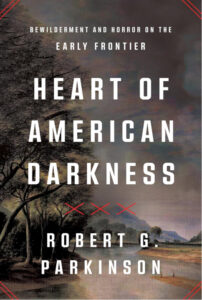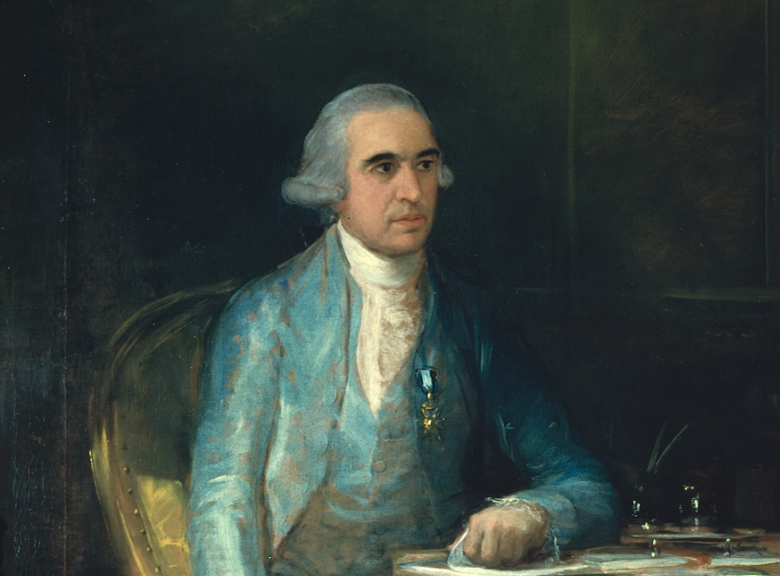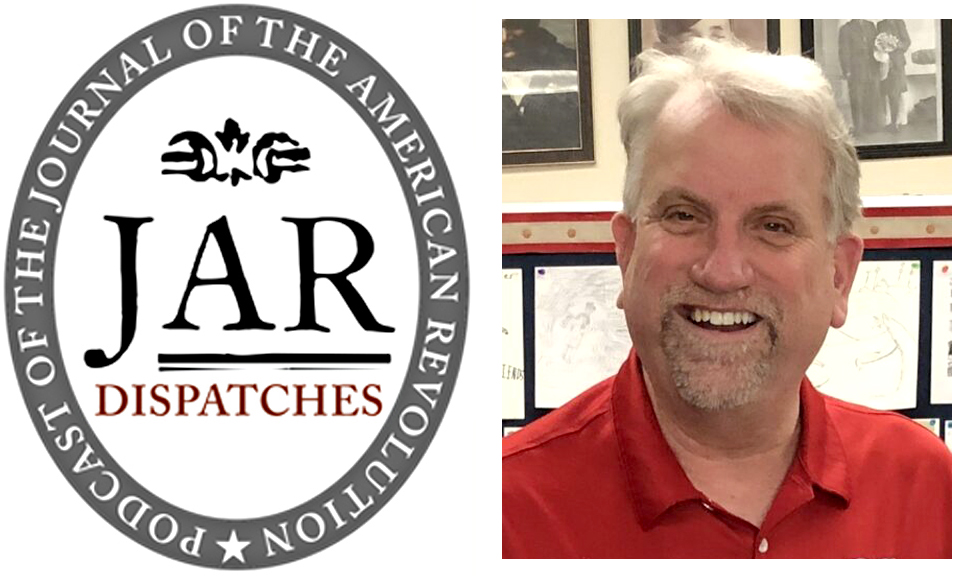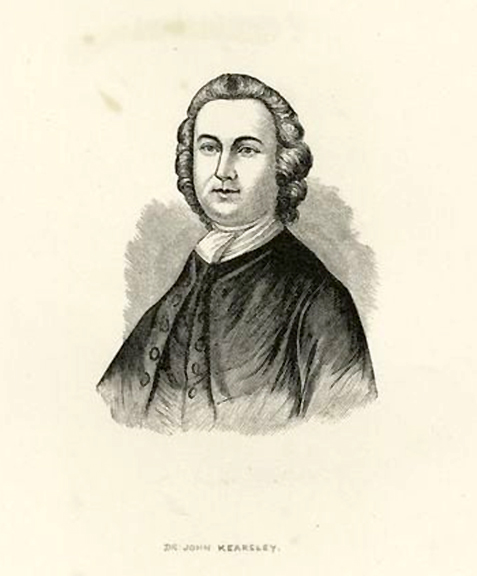BOOK REVIEW: Heart of American Darkness: Bewilderment and Horror on the Early Frontier by Robert G. Parkinson (New York, NY: W. W. Norton & Company, 2024. $35.00, hardcover)
Robert G. Parkinson, a history professor, chronicles the pre- to post-American Revolutionary War events in the Ohio Valley through the experiences of two families—the Native Shickellamys and the colonialist Cresaps. Each of the families suffered premature loss of kin and other tragedies during the French and Indian War, Pontiac’s Rebellion, Lord Dunmore’s War, the American Revolutionary War, and the later Native/Colonialist conflicts.
 The Shickellamy clan begins with its eponymously named patriarch, born circa 1700, a Oneida Indian and Iroquois/Six Nations diplomat residing at Shamokin (modern-day Sunbury, Pennsylvania). Shickellamy’s wife, Neanoma, bore one daughter, Koonay, and five sons, John Logan Shickellamy (Tachnedorus), James Logan Shickellamy (Soyechtowa), John Petty Shickellamy, “Unhappy Jake,” and an unnamed infant. Jesse Logan, grandson of Tachnedorus, who died in 1916, is the last member of the Shickellamy clan to appear in Parkinson’s narrative. Shickellamy enjoyed close, friendly relationships with several influential colonists. The patriarch named his first two sons after James Logan, a controversial Pennsylvania Indian agent. John Gibson, a prominent Indian trader, married Shickellamy’s daughter, Koonay.
The Shickellamy clan begins with its eponymously named patriarch, born circa 1700, a Oneida Indian and Iroquois/Six Nations diplomat residing at Shamokin (modern-day Sunbury, Pennsylvania). Shickellamy’s wife, Neanoma, bore one daughter, Koonay, and five sons, John Logan Shickellamy (Tachnedorus), James Logan Shickellamy (Soyechtowa), John Petty Shickellamy, “Unhappy Jake,” and an unnamed infant. Jesse Logan, grandson of Tachnedorus, who died in 1916, is the last member of the Shickellamy clan to appear in Parkinson’s narrative. Shickellamy enjoyed close, friendly relationships with several influential colonists. The patriarch named his first two sons after James Logan, a controversial Pennsylvania Indian agent. John Gibson, a prominent Indian trader, married Shickellamy’s daughter, Koonay.
The Cresap family patriarch, Col. Thomas Cresap, was also born around 1700, served in many influential public positions, and founded Oldtown, Maryland, a central launching point for contesting the Ohio Valley. He and his wife Hannah produced two daughters, Elizabeth and Sarah, and three sons, Daniel, Thomas, Jr., and Michael. All three sons were involved in Indian trading, land speculation, and warfare. Daniel established a settlement in modern-day Williamsport, Maryland, and sent three sons to fight in Lord Dunmore’s War and the Revolution. Thomas was killed in the French and Indian War. Contemporary news accounts inappropriately attributed to Michael the murder of eight Natives. Michael died of natural causes on his way to join George Washington’s army besieging Boston in 1775, becoming a minor hero afterward. Thomas Cresap also engaged in a long-term, bigamous relationship with Elizabeth Lamy, fathering a daughter, Jane Cresap.
In this, his third book, the author takes a unique approach to the dual family histories, using Joseph Conrad’s novella, Heart of Darkness, to frame their participation in the bitter eighteenth-century Ohio Valley conflicts.[1] Conrad’s masterpiece critiques European colonial rule in late nineteenth-century Africa by examining power dynamics and morality. The turn of the twentieth century novelist depicts London as the greatest town on earth and Africa as a place of darkness. Building on Conrad’s assessment of colonial Africa, Parkinson suggests that the imperial conflicts between settler Americans and Natives share similarities, offering a deeper understanding of their meaning beyond the racist savage-versus-civilized explanations. He sees Conrad’s central image of mayhem and bewilderment in the Revolutionary Era Ohio Valley. To reinforce the Heart of Darkness connections, Parkinson introduces each chapter with a brief passage from Conrad’s book. While Conrad’s Heart of Darkness is a commanding and well-established critique of colonial imperialism, it is also controversial among several colonial and African scholars. One reviewer criticizes Conrad for characterizing Africans as primitive and attacking Belgian colonialism while supporting the British variety.
While readers and scholars can argue over the Heart of Darkness’s legacy, all can benefit from Parkinson’s arguments by avoiding Conradian disputes. The author’s principal aim is to describe and interpret the double dispossessions of Natives by colonists through the Shickellamy and Cresap families. First, the American government forcibly removed the Shickellamy and other native families from their homelands, and later, their history was erased or obscured through purposeful historical appropriation. Parkinson’s meticulously researched double dispossession narrative dispels the abundant and misleading folklore emerging well after the events.
Parkinson sorts through a couple of hundred years of controversy over basic facts and meaning, providing his interpretations for two seminal events anchoring the well-written, engaging frontier narrative. First, settlers from the Western region of Virginia murdered eight Indians, including three members of the Shickellamy family, the patriarch’s wife, youngest son, and granddaughter, in what came to be known as the Yellow Creek Massacre. The April 1774 event generated blockbuster news throughout British North America, branding Michael Cresap as the killers’ leader. Parkinson conclusively demonstrates that Cresap could not have been the killer and sets the historical record straight on several other grisly factors. The author asserts that Daniel Greathouse, a settler on the Ohio River, was the ringleader of the Yellow Creek Massacre. However, historians may never ascertain conclusively many of the gruesome details. As a result of the murkiness, the killings became a significant aspect of American folklore well afterward.
Second is Logan’s Lament, a speech by a Mingo chief, which grieves the loss of his family, culture, and lands to the encroaching colonial settlers. Lord Dunmore, Virginia’s last Royal Governor, documented Logan’s speech based on the testimony of John Gibson, who translated and transcribed the speech. Aroused by its message, James Madison arranged its publication in the Pennsylvania Journal. Numerous newspapers across British North America republished the story, making it one of the most famous speeches of the colonial era. While Thomas Jefferson got many facts wrong, he included Logan’s speech in his Notes of the State of Virginia. He sought to counter French intellectuals who believed North American residents suffered from degeneracy.
Due to this early publicity, Logan’s Lament entered American folklore. As scholars delved into its history, arguments about its basic facts emerged. Parkinson details the various points of view, including which Shickellamy brother, James or John, was the author. Based upon oral evidence from a surviving grandchild in 1915, the author concludes that James spoke to an Indian trader, John Gibson, about his lamentations. He concludes that a family member is likelier than another observer to know which brother produced the eloquent, heartfelt message.
Readers will encounter many fascinating observations not usually found in other accounts of “middle ground” life.[2] For example, the Natives believed that the American settlers acted in tribes, with Pennsylvanians fighting Virginians much the same as the warring Indians. They were not wrong, as the two colonies had overlapping land claims, leading to angry physical and legal altercations for political control and land titles. Another tidbit is that Col. George Gibson, Jr., the US Army officer in charge of the Indian Removal logistics in 1837, deported at least one member of his extended family across the Mississippi River. Gibson harshly escorted a Native contingent to the Indian Territories, which included Polly Gibson, the daughter of Koonay and John Gibson, who survived the Yellow Creek Massacre. George and Polly were first cousins and about the same age. Whether they reconnected their family lineages is lost to history.
Finally, Thomas Jefferson engaged in a bitter battle to refute allegations of improper and misleading accounts of his characterization of Logan’s Lament. Presidential candidate Jefferson issued a fifty-page appendix to the Notes on the State of Virginia in April 1800, attempting to clear his name by correcting his account to reflect that Michael Cresap had killed Natives on the Ohio River but was not at the Yellow Creek Massacre and that John Gibson had confirmed the accuracy of Logan’s speech and other details of his account of Logan’s Lament.
Readers would have benefited from a more fulsome account of the cultural and commercial exchanges between Natives and colonists. For example, through extensive trading networks, Indian lives fundamentally changed in the eighteenth century due to the acquisition of guns, clothing, and tools. These technologies became essential to sustaining and protecting Native communities. Before the French and Indian Wars, Native and colonial traders conducted their commerce relatively nonviolently. After the British vanquished the French from the Ohio Valley, colonial settlement mushroomed, and violence and conflict increased dramatically. Competition for land, not commerce, created the horrendous violence. Indians faced an unenviable situation; they desperately needed goods from colonists that they wanted to keep out of their lands.[3]
Despite my suggestion to better describe the changes in Native-colonial relationships, the Heart of Darkness is an excellent portrayal of clashing societies and their often destructive impact on individuals. The author’s long-term interest in the Cresap and Shickellamy families is palpable throughout the monograph. The focus on the two families avoids the tendency of many writers to homogenize cruelty, death, and derangement by recounting history in the abstract. Parkinson avoids this trap, providing readers with a troubling account of what it was like to live in the contested Ohio Valley. The region’s residents experienced bewilderment and horror, which the author fittingly includes in his subtitle.
PLEASE CONSIDER PURCHASING THIS BOOK FROM AMAZON IN CLOTH or KINDLE. (As an Amazon Associate, JAR earns from qualifying purchases. This helps toward providing our content free of charge.)
[1] Robert G. Parkinson, The Common Cause: Creating Race and Nation in the American Revolution (Chapel Hill: Published for the Omohundro Institute of Early American History and Culture, Williamsburg, Virginia, by the University of North Carolina Press, 2016); Robert G. Parkinson, Thirteen Clocks: How Race United the Colonies and Made the Declaration of Independence (Williamsburg, Virginia : Chapel Hill: Omohundro Institute of Early American History and Culture ; University of North Carolina Press, 2021).
[2] Richard White, The Middle Ground: Indians, Empires, and Republics in the Great Lakes Region, 1650-1815 (New York: Cambridge University Press, 2011).
[3] For a recent description of Native/Colonial trading relationships, see, Jason A. Cherry, William Trent – Factor of Ambition (Mechanicsburg, PA: Sunbury Press, Inc., 2024).









4 Comments
Gene,
Thanks for this review. I was kicking around the idea of a project on Logan’s War when Parkinson’s book popped up on my “new and forthcoming” list. I haven’t added it to my library, in part because I was coming to the conclusion that there wasn’t enough solid material available to do the story justice. Before you know it, you’re hip deep in myth, legend, and folklore. Parkinson’s decision to borrow from Joseph Conrad only put me off further. (The most solid examinations of the Yellow Creek Massacre pretty much exonerated Cresap and pinned the crime on the Greathouse clan years ago, so Parkinson’s conclusion isn’t all that revelatory.) Does he identify shortfalls in the available documentary evidence and place the Yellow Creek Massacre in the context of the cycles of violence that came before and after the event? (Native American retaliation for the massacre became part of the rationale for Dunmore’s War that year).
Eric,
Thank you for the observation that Parkinson’s revelation about Michael Cresap’s non-participation in the Yellow Creek Massacre was long ago debunked. In terms of new knowledge, the author’s deep focus on the two families is unique. He addresses two myths by examining the changing memories of the Yellow Creek Massacre and Logan’s Lament. It sounds like you have identified many more. The strength of Heart of American Darkness is a duo family story and not a general account of the Pre-American Revolution Ohio Country. Gene
Thank you.
Great stuff to unravel esp relearning again how close this territory could’ve remained British…!